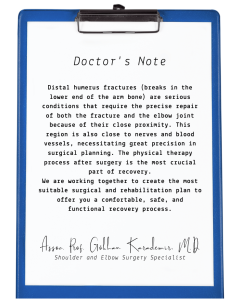The elbow joint, which includes the upper arm bone (humerus) and the forearm bones (radius and ulna), is a highly complex and sensitive structure. The lower end of the humerus, near the elbow (known as the distal humerus), can break, especially after trauma or a fall. Fractures in this region are injuries with significant functional consequences because they often extend into the joint and directly affect movement.

These types of fractures typically occur in older individuals due to osteoporosis (thinning of the bones), whereas in younger patients, they are usually caused by high-energy trauma. Surgical treatment is necessary for fractures that involve the joint surface, are fragmented into multiple pieces (comminuted), or are displaced (out of normal alignment). Surgery involves anatomically repositioning the broken fragments and stabilizing them with special plate-and-screw systems. The goal is both to ensure the fracture heals and to preserve the elbow’s range of motion.
Because distal humerus fractures are very close to the region where nerves and blood vessels pass, the surgery must be planned carefully. Following a surgery performed with the appropriate technique, the physical therapy process is the key to a successful functional recovery.

Surgery Duration: 1.5-2.5 hours
Anesthesia Type: General anesthesia or a brachial plexus block (a regional nerve block that numbs the entire arm).
Surgical Method: Open surgery to anatomically align the fracture fragments, followed by stabilization using dual plate-and-screw systems.
First day: 5–6
First week: 4–5
After the 2nd week: 1–2
Usually 1–2 days The stay may be longer in cases of advanced age or accompanying medical conditions (comorbidities).
First 2–3 weeks: Supported with an arm sling; a splint may be used.
Starting from the 3rd week: Passive motion exercises begin (movement guided by a therapist or the other arm).
6th week: Active motion (moving the arm on its own) and strengthening exercises.
3rd month: Return to daily functions.
6th month: Full functional recovery; return to sports is possible.
First dressing change: 2nd day
Wound check: 1st week
Suture removal (if necessary): 10th day
Fractures with very few fragments that are not displaced (out of position) can rarely be managed non-operatively. However, surgery is essential for fractures that extend into the joint, are fragmented, or are unstable.
If exercises are started on time, the range of motion can largely be preserved. The risk of restriction increases if therapy is delayed.
The elbow joint is prone to stiffness (contracture). Early and regular exercises are critical to prevent functional loss. In most cases, it is sufficient and safe for our patients to perform the exercises we provide them. If it is determined during follow-ups that the expected range of motion is not being achieved, assistance from a formal physical therapist may rarely be sought.
In most cases, the plates can remain for life. However, they may be removed after 1 year in young patients or if they cause discomfort.
A return to desk jobs is possible after 3–4 weeks, and to physical labor after 2–3 months.